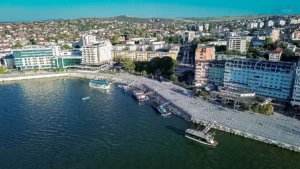
Great Cormorant

Description and how to observe Great Cormorant:
The Great Cormorant is a medium to large waterfowl, about 80-100 cm long with a wingspan of up to 160 cm. Its plumage is predominantly black with metallic greenish-green reflections, and it may sometimes have a whitish patch on the neck. Bright green eyes are a distinctive feature.
To observe them, visit the lakes, canals and open water areas of the Danube Delta. Cormorants can often be seen sitting on the banks or tree trunks, spread-winged to dry themselves, or diving nimbly into the water after fish.
What it feeds on Great Cormorant:
The great cormorant is a specialised predator, feeding mainly on fish. It is an excellent swimmer and can dive to considerable depths to capture prey. It usually favours small to medium-sized fish, but its diet may also include crustaceans or other aquatic life.
Threats:
The great cormorant population faces threats such as habitat destruction, water pollution and conflicts with fishermen who perceive them as competitors. Human activities and climate change can also affect nesting areas and food sources.
Ecological role:
More information about Phalacrocorax carbo:
- The great cormorant is protected under national and international law and is included in wild bird conservation conventions.
- The Danube Delta is home to some of the largest colonies of cormorants in Europe, making this region a hotspot for birdwatchers and tourists.
- Cormorant watching contributes to ecotourism, giving visitors a better understanding of the delta's biodiversity.
Discover now the most beautiful places in the Danube Delta!
In the following pages, you will find detailed information about:
- Top tourist destinations: Traditional villages, nature reserves, tourist trails and much more.
- Activities and attractions: Everything you need to know about boating, fishing, bird watching, cycling and other activities.
- Accommodation and catering: Accommodation to suit all budgets and restaurants serving traditional cuisine.




